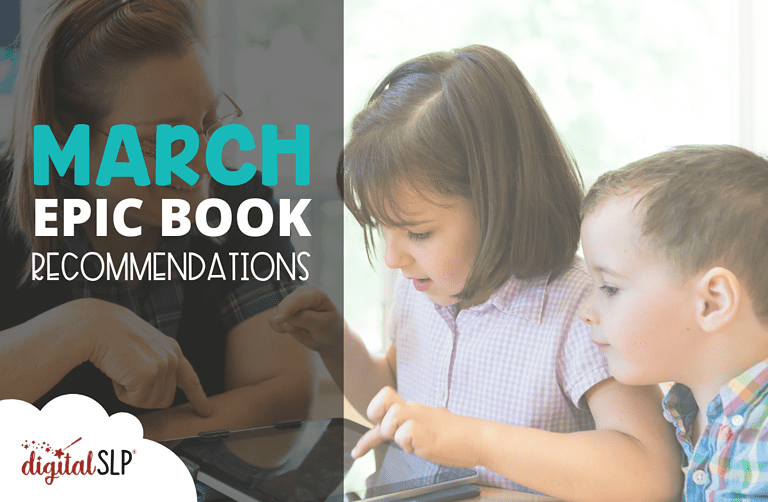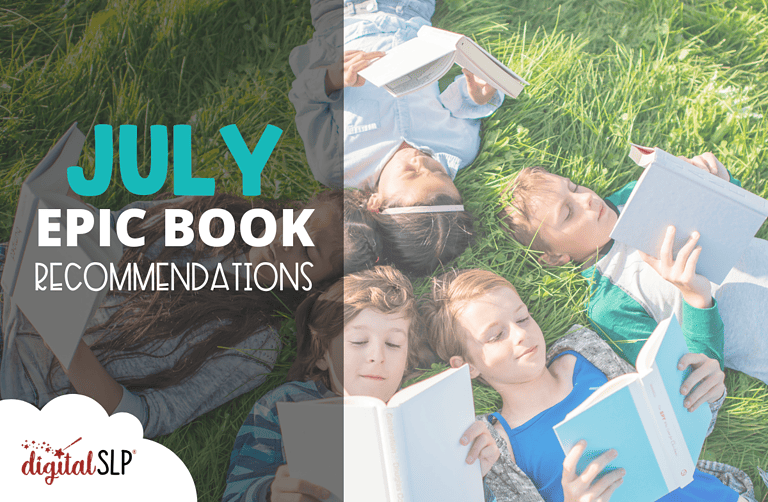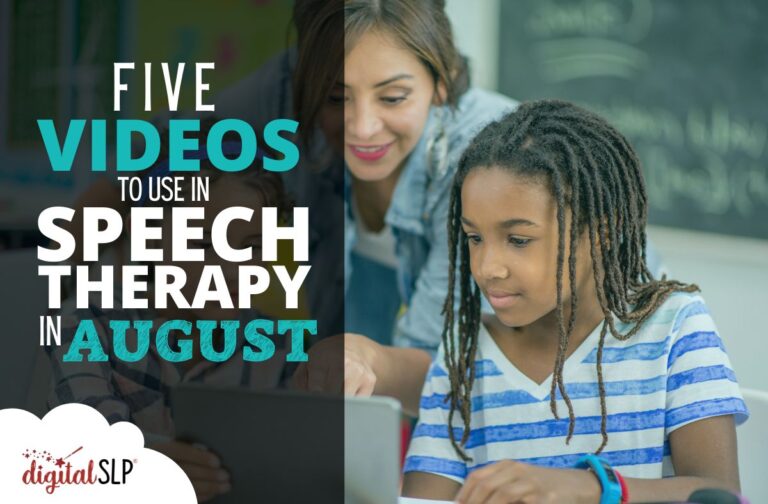This post contains affiliate links for which we may receive compensation at no additional cost to you. Click here to read our full affiliate policy.
Spring is (almost) here! As rain falls, leaves grow, and flowers bloom, here are five special March Epic book recommendations for you.
Pig is Big on Books
Spring rain brings spring mud, which is sure to make pigs happy! Conveniently, March 1st is also National Pig Day in the United States, so it’s the perfect time to read Douglas Florian’s cheerful picture book filled with crayon-like illustrations.
Very young learners are likely to connect with Pig’s joyful love of reading, and they might be inspired by his creative solution when he runs out of books!
Therapy ideas and skills to target:
- Personal narrative and discussion: students could talk about their favorite types of books, who they like to read with, and where they like to read.
- Describing: this book has accessible illustrations with occasional surprises (e.g., a bear riding a bicycle)—students could describe what they see.
- WH-questions: the book focuses on where Pig reads and who reads with him, so it’s a great opportunity to practice these types of questions.
- Extension: students could design and create their own books—just like Pig!
Grab a paperback copy of Pig is Pig on Book!
Sweet Dreams, Sarah
Women’s History Month is observed every year in March. The 2023 theme is “Celebrating Women Who Tell Our Stories,” and this next recommendation is a great way to do just that!
With compelling text from Vivian Kirkfield and gorgeous illustrations by Chris Ewald, this biography shares about the life of Sarah E. Goode, who became one of the first Black women to hold a patent in the United States.
This uplifting book is especially relevant for late elementary/early middle school students who experience anxiety related to making mistakes.
Therapy ideas and skills to target:
- Sequencing and retell: students could explain the events of Sarah’s life in chronological order.
- Character traits and inferences: students could use evidence from the biography to make informed guesses about Sarah’s character traits.
- Personal narrative and connections: students could share about a time they felt like giving up but didn’t, or what they would say to a friend who was discouraged about a project.
- Extension: the US Patent and Trademark Office website has a fun “Build/Make an Invention” section that students might enjoy exploring.
Sweet Dream, Sarah is also available in hardcopy format.
Busy Spring: Nature Wakes Up
In the Northern Hemisphere, spring officially begins in late March, but it’s never too early to start planning for this season of new beginnings!
This beautiful book (written by Sean Taylor and Alex Morss and illustrated by Cinyee Chiu) is a tribute to the many wonders of spring, including birds, bugs, frogs, plants, and baby animals.
Busy Spring would be the perfect kick-off for a spring thematic unit—it really does have a little bit of everything.
Therapy ideas and skills to target:
- Personal narrative and connections: in addition to its focus on seasonal changes, Busy Spring emphasizes the narrator’s relationship with her younger sister. Students could discuss their relationships with siblings (or other family members) and compare their experiences with the narrator’s.
- Describing: the illustrations in this book are richly detailed, and students could describe what they see.
- Predicting: students could share what they think would happen next if the book continued.
- Extension and sequencing: Spring is full of sequencing opportunities! Students could research and explain the life cycle of a frog or butterfly. They could also talk about how to make compost or plant a garden. They could even build their own bird nests!
This beautifully illustrated book about spring is available in hardcover and paperback formats via Amazon.
Why Am I Blue? A Story About Being Yourself
Most of us probably have students on our caseloads who feel lonely and disconnected. They may dislike feeling different and struggle to embrace their unique strengths. Using gentle humor, Why Am I Blue? encourages these students to consider seeing the world differently.
Importantly, Kalli Dakos’ playful story and Viviana Garofoli’s vibrant illustrations avoid pretending that differences don’t matter. Rather, they warmly remind students that differences can be a beautiful part of life.
As a little bonus, this picture book is also perfect for World Frog Day on March 20!
Therapy ideas and skills to target:
- Feelings: throughout the book, the Blue Frog and the characters he meets express emotions, sometimes explicitly and sometimes implicitly. Students could practice identifying and describing these feelings.
- Comparing and contrasting: the Blue Frog meets a variety of creatures throughout the book. Students could discuss the similarities and differences between the Blue Frog and everyone he encounters.
- Personal narrative and connections: students could share ways in which they might identify (or not) with the Blue Frog’s experiences.
- Extension: students could create posters (or other art projects) that highlight their unique qualities, strengths, and interests.
Grab this super cute book in hardcover.
Poem in My Pocket
A vivid tribute to the magic of words, this short book is a wonderful companion to World Poetry Day on March 21. It also offers students a lighthearted opportunity to observe and practice phonological awareness skills such as rhyming and syllable manipulation.
Each page is a treasure trove of creativity from illustrator Josée Bisaillon, and students will grin at the clever puns from author Chris Tougas.
Therapy ideas and skills to target:
- Describing: there is so much to see and talk about on each page of this book! Students could offer their observations about the various objects, colors, people, and animals that are included.
- Humor: for many students who are working on language skills, understanding and/or sharing jokes can be challenging. Poem in My Pocket is full of puns and visual humor to help students learn how to play with language.
- Verbs: this book brings words to life with punchy verbs like “slide,” “whirl,” “scatter,” and “mingle.” Students could use the pictures from the book to help them determine the meaning of unfamiliar verbs.
- Extension: students could create their own poems! Some structured forms to explore include haiku, cinquain, acrostic, and found poetry.
Poem in the Pocket is also available in hardcover!
I hope you have find my March Epic book recommendations to be useful. All of these books are available for free through Epic when you sign up for an educator account, or you could request them from your local library. Enjoy!
Want to stay in the loop for new speech therapy ideas and inspirations? I have put together a free Digital SLP podcast to share insight and tips on implementing your speech therapy sessions. If you are looking for fun and interactive speech therapy materials that students and SLPs both will love, check out what the Digital SLP® membership site has to offer, or sign up for our free trial now. Alternatively, check out our TpT store.













Recent Comments